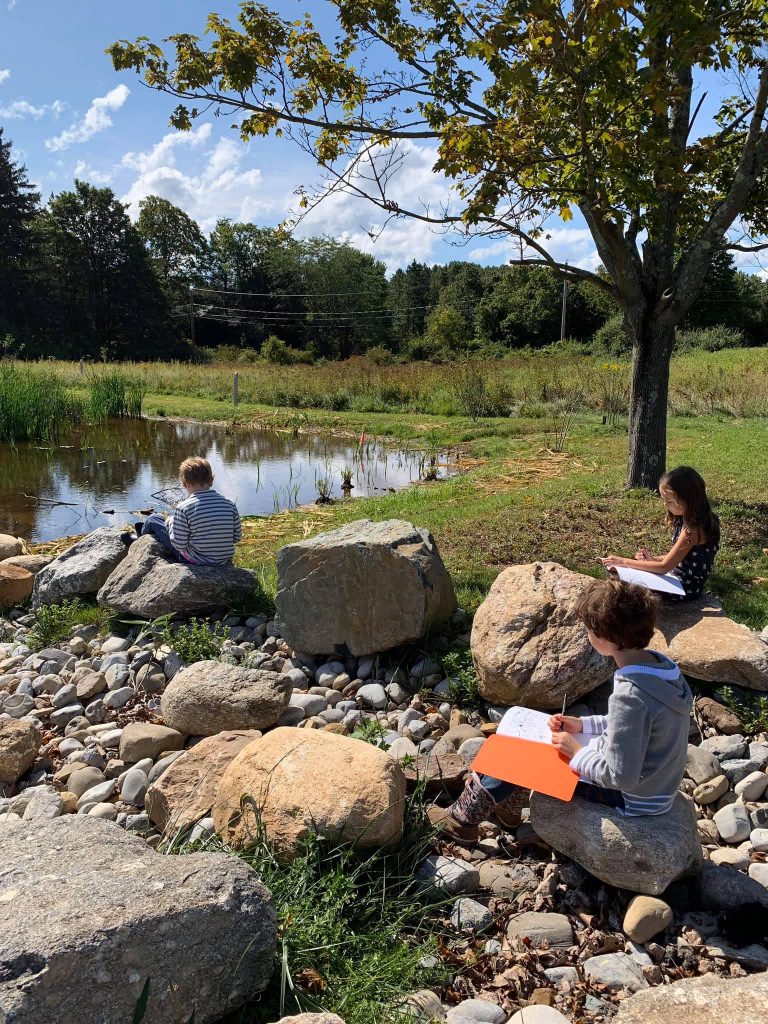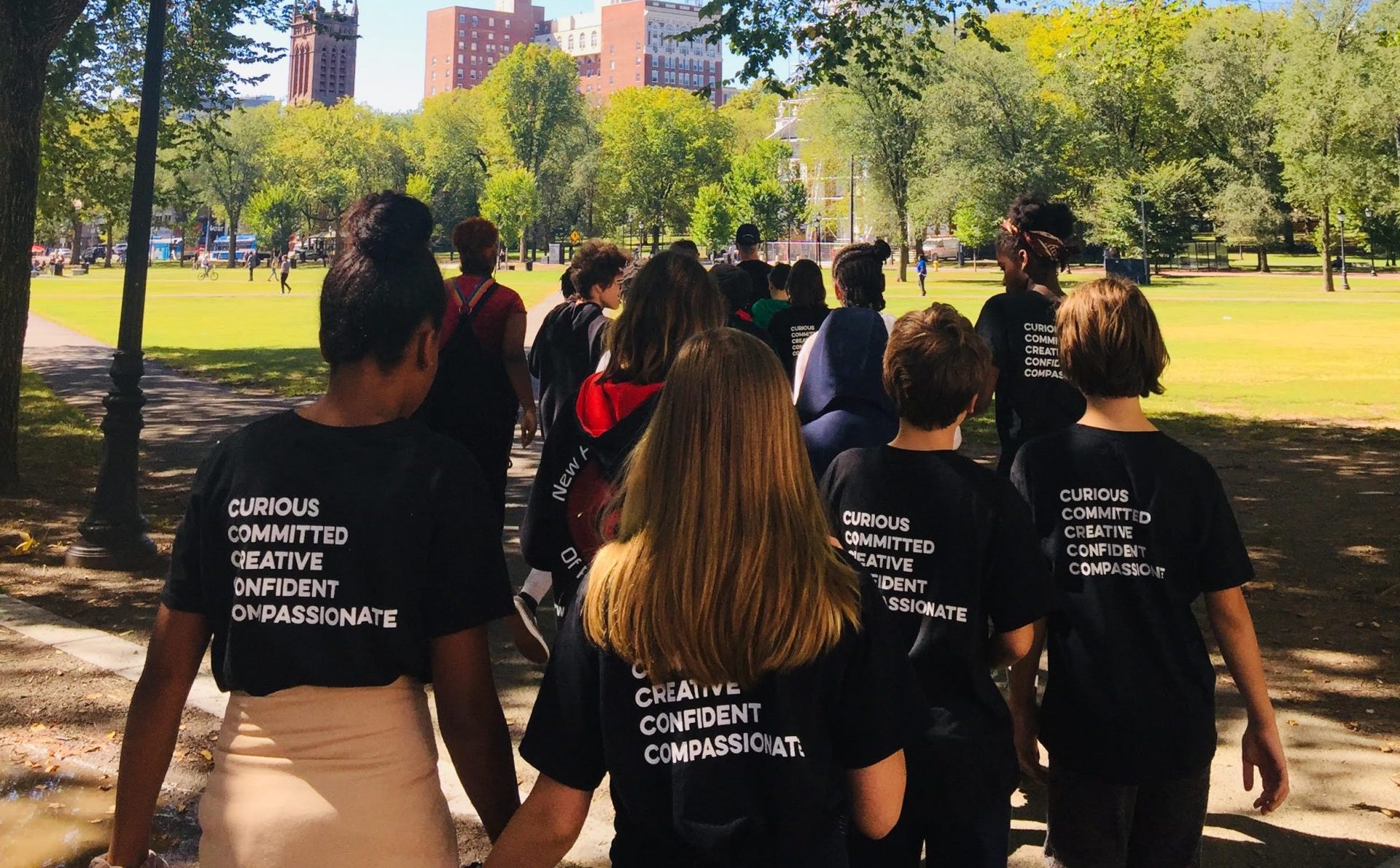
It’s the beginning of a school day at ATLAS. The seventh graders enrolled there aren’t working through math problems, discussing U.S. history, or doing any of the activities you might expect at a middle school, however.
They’re running lines and stage direction for their upcoming performance of the play “The Giver,” which the students there have completely planned, from costume design to creating marketing materials. Not to mention that they’re doing the lighting, have created the set, and are acting in the play, which will cap off their fall semester.
That’s the whole idea at the theater-based middle school, which opened in 2019 with a class of seventh graders and will be expanding to include eighth graders next year. ATLAS – which is located at Neighborhood Music School, a non-profit arts school in New Haven – is an alternative school where students learn through running a theater company.
It’s one of many alternative schools in the state that provide a unique educational landscape for families and students who want – or need – something other than the norm. From private schools (like ATLAS) to charters, magnet schools, and alternative schools within the public system, these educational institutions provide a huge range of educational methodologies.
These schools exist all over the state, and the New Haven area alone is home to many, including newer schools, like ATLAS, as well as established alternative schools like Common Ground, the nation’s longest-running environmental charter school, opened in 1997. The high school emphasizes environmental stewardship in its curriculum, and the campus includes an onsite urban farm, giving students real-life lessons about sustainable living and the opportunity to contribute to New Haven’s food system. The school also runs a host of programs for families focused on connecting visitors to the natural world.
As with other alternative schools, the curriculum at ATLAS might seem like completely unfamiliar territory, at least at first. But learning through theater is a dream come true for some students looking for a completely different middle school experience.
A typical day at the school, which begins with “movement and meditation,” clearly indicates the creative ways ATLAS staff incorporate lessons into the theater theme. STEM (science, technology, engineering, and mathematics) learning is infused into all aspects of stagecraft, such as costume design, which students complete at a station in one of their classrooms, complete with spare material and measuring tools. Students learn humanities lessons by comparing aspects of their play with connections to current events, and recognize individual intellectual specialties through an “objectives” course, pursuing self-directed projects like photography or choreography.
“I feel like in any school in the first year, the number one goal is building a culture,” says Founding Artistic Director Maria Bartz. “The students here have really co-created that.”
Bartz created the concept for the school with Founding Education Director Caroline Golschneider, and staff also includes Billy O’Shea, the STEM director, as well as a roster of specialty instructors.
The result of students collaborating to reach such a specific educational goal has resulted in a cohort of inspired and inspiring students, unusually connected to their shared ideals and to one other.
“We’re all different, but we are all like a big family,” says student Giada, who declined to give her last name.
Call of the Wild
At Slate School in North Haven, a nature-based elementary school that opened in the fall of 2018, large sliding doors and windows look onto a pristine courtyard, central to the bucolic 25-acre campus. The setup is meant to provide students a seamless transition from inside to out, allowing children to explore many different workspaces at the school and roam the campus regularly, investigating wildlife, native plants, and the changing seasons.
The school itself is a natural wonder, crafted from environmentally friendly materials, such as sustainably forested wood, with circadian rhythm lighting that mimics the natural light of the sun and changes throughout the day.
“This is a powerful space,” says Julie Mountcastle, head of school and a second-grade teacher from the Grove, one of the bright, airy school buildings where student art projects dot the walls. All of the classroom buildings, such as Apple Tree and Wildlflower, have nature-inspired monikers.
The Slate School, created by couple Jennifer Staple Clark and Alexander Clark, emphasizes student-led projects, which direct the overall learning. Children choose subjects, examine texts and other learning materials, and gather “artifacts,” working with teachers to fill their notebooks with “impressions, facts, and more questions,” according to the school’s website.
“We teach them through the lens of their curiosity,” says Mountcastle of the process, which favors a hands-on approach, with students working side by side on different subjects. In one classroom, for instance, a teacher encouraged a curious student as he conducted an experiment, floating different materials in a bucket of water. Nearby, another student sat engrossed in a book about squirrels.
There are many other ways Slate School differs from a typical school structure: the faculty includes a writer-in-residence who works onsite, and will soon include a fully functioning greenhouse, accessible during all seasons.
But the fundamental goal is encouraging each student’s individual creativity, says Jennifer Staple Clark.
“It’s phenomenal seeing the children,” she says. “They’re just so excited about everything they’re learning.”
Side By Side
Dr. Anne Dichele is dean of the School of Education at Quinnipiac University, as well as one of the founders of the Side By Side Charter School in Norwalk, one of Connecticut’s first state-funded charter schools. The school opened in 1997.
She says that she understands the desire for alternative educational outlets, and that starting new schools is certainly the prerogative of those who choose to do so. But she adds that a potential downside of the trend occurs when public education systems are neglected in the process.
“The issue is when people begin to think of schooling as a commodity, as something you can buy or choose,” she says. “Whereas public education is really a civic commodity.”
She is proud that the Side by Side Charter School has stayed true to its original mission over the years. The school, which has been recognized by the state for its successes, is a small, innovative institution that serves a community in need, instilling social justice ideals in its high-achieving students, she says.
According to its mission statement, Side By Side’s staff members help students “build character and responsibility through a commitment to community, social justice, and tolerance towards others.”
The school’s downtown SONO location “enables our students and faculty to partner with surrounding art centers, museums, Long Island science studies, festival performances, and neighboring commerce. Through challenging and enriching hands-on activities, SBS focuses on high academic standards, respect, tolerance, and success.”
“Initially, charter schools were meant to be labs of innovation, says Dr. Dichele. “They were opportunities to not have to deal with red tape and give teachers more autonomy.”
She fears, however, that many charter schools are becoming money-making ventures for corporations that run them. School, she says, “can’t just be a commodity; it has to be a civic obligation.”
An Alternative Path
Alta at the Pyne Center is an alternative high school, but it is part of the Southington Public School District. The “school of choice” serves students referred through Southington High School, who may not have been successful in a traditional setting.
Referrals come in for a variety of reasons, says Jess Levin, director of the school. Some students thrive better in a smaller school environment (Alta typically enrolls 40 to 50 students total) and some are experiencing anxiety or emotional issues.
That being said, the school aligns itself with the traditional high school’s curriculum, allows its students to utilize programming at the high school and expects academic excellence from those enrolled, Levin says. But what Alta does well, through smaller class sizes and alternative programming, is to help students thrive in an environment that allows them to express themselves individually and work towards goals at their own pace.
The school’s trout farm, for example, is a grant-funded program, allowing Alta students to grow trout from eggs and release them into a nearby waterway each spring. The project gives the students a uniquely close-up look into the world of aquatic life, says Levin, but also teaches responsibility and observation skills in a real-world way.
Students also join advisory groups, made up of six or seven students each, that meet weekly to touch base and set goals. “We can be a lot more flexible here, and that’s important because a lot of our kids do come from challenging backgrounds,” Levin says. “We can work creatively, and individually, with each student.”
School counselor Mark Hill says these alternative experiences, and the close relationships school faculty are able to forge with students, can make an incredible difference.
“I literally can say that I speak to each kid every day, and that’s awesome,” he says. “Every student has at least one staff member they are really close with.”
Dan Patterson, who is a social studies teacher at Alta, says that the biggest success is getting students in the front door every day, in a place where they can truly learn.
“We believe that every student matters. They all have bright futures and it’s our job to tap into their interest,” he says. “One of the most rewarding things that we can get out of teaching at Alta is seeing students grow over time and getting them through their struggles and adversity. Somehow, we are this big fishbowl with a lot of different personalities, but it really gels together.”







More Stories
Foraging Around the Nutmeg State
Moving Up: Florida to Connecticut for Seasons, Schools and Safety
Listen Here! The Declining Art of Listening